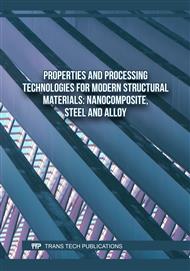[1]
Raghukiran N and Kumar R. (2013). Processing and dry sliding wear performance of spray deposited hyper-eutectic aluminum–silicon alloys. J Mater Processing Technol 213(3):401–410.
DOI: 10.1016/j.jmatprotec.2012.10.007
Google Scholar
[2]
Alcaraz JYI, Foqué W, Sharma A and Tjahjowidodo T. (2023). Indirect porosity detection and root-cause identification in WAAM. J Intell Manuf.
DOI: 10.1007/s10845-023-02128-x
Google Scholar
[3]
Wu B, Pan Z, Ding D, Cuiuri D, Li H, Xu J and Norrish J. (2018). A review of the wire arc additive manufacturing of metals: Properties, defects and quality improvement. J Manuf Processes 35:127–139. (2018).
DOI: 10.1016/j.jmapro.2018.08.001
Google Scholar
[4]
Scharf-Wildenhain R, Haelsig A, Hensel J, Wandtke K, Schroepfer D and Kannengiesser T. (2023). Heat control and design-related effects on the properties and welding stresses in WAAM components of high-strength structural steels. Weld World 67:955–965.
DOI: 10.1007/s40194-022-01450-x
Google Scholar
[5]
Vazquez L, Rodriguez MN, Rodriguez I, Alvarez P. (2021). Influence of Post-Deposition Heat Treatments on the Microstructure and Tensile Properties of Ti-6Al-4V Parts Manufactured by CMT-WAAM. Metals.11(8):1161.
DOI: 10.3390/met11081161
Google Scholar
[6]
Wu Q, Mukherjee T, De A and DebRoy T. (2020). Residual stresses in wire-arc additive manufacturing – Hierarchy of influential variables. Add Manuf 35:101355.
DOI: 10.1016/j.addma.2020.101355
Google Scholar
[7]
Derekar K, Lawrence J, Melton G, Addison A, Zhang X and Xu L. (2019). Influence of Interpass Temperature on Wire Arc Additive Manufacturing (WAAM) of Aluminium Alloy Components. MATEC Web of Conf 269:05001.
DOI: 10.1051/matecconf/201926905001
Google Scholar
[8]
Colegrove PA, Donoghue J, Martina F, Gu J, Prangnell P and Hönnige J. (2017). Application of bulk deformation methods for microstructural and material property improvement and residual stress and distortion control in additively manufactured components. Scripta Materialia 135: 111–118.
DOI: 10.1016/j.scriptamat.2016.10.031
Google Scholar
[9]
Dirisu P, Supriyo G, Martina F, Xu X and Williams S. (2020). Wire plus arc additive manufactured functional steel surfaces enhanced by rolling. Int J Fatigue. 130:105237.
DOI: 10.1016/j.ijfatigue.2019.105237
Google Scholar
[10]
Busachi A, Erkoyuncu J, Colegrove P, Martina F and Ding J. (2015). Designing a WAAM Based Manufacturing System for Defence Applications. Procedia CIRP. 37:48–53.
DOI: 10.1016/j.procir.2015.08.085
Google Scholar
[11]
Cunningham CR, Wikshåland S, Xu F, Kemakolam N, Shokrani A, Dhokia V and Newman ST. (2017). Cost Modelling and Sensitivity Analysis of Wire and Arc Additive Manufacturing. Procedia Manuf. 11:650–657.
DOI: 10.1016/j.promfg.2017.07.163
Google Scholar
[12]
Hönnige JR, Colegrove PA, Ahmad B, Fitzpatrick ME, Ganguly S, Lee TL and Williams SW. (2018). Residual stress and texture control in Ti-6Al-4V wire + arc additively manufactured intersections by stress relief and rolling. Mater Design, 150:193–205. (2018).
DOI: 10.1016/j.matdes.2018.03.065
Google Scholar
[13]
Colegrove PA, Coules HE, Fairman J, Martina F, Kashoob T, Mamash H and Cozzolino LD. (2013). Microstructure and residual stress improvement in wire and arc additively manufactured parts through high-pressure rolling. J Mater Process Technol 213(10).
DOI: 10.1016/j.jmatprotec.2013.04.012
Google Scholar
[14]
Hönnige JR, Williams S, Roy MJ, Colegrove P and Ganguly S. (2016). Residual Stress Characterization and Control in the Additive Manufacture of Large-Scale Metal Structures. Int Conf on Residual Stresses (ICRS-10), 3 - 7 July, Sydney, Australia, 2:455-460.
DOI: 10.21741/9781945291173-77
Google Scholar
[15]
Williams SW, Martina F, Addison AC, Ding J, Pardal G and Colegrove P. (2016). Wire + Arc Additive Manufacturing. Mater Sci Technol 32(7):641–647.
DOI: 10.1179/1743284715y.0000000073
Google Scholar
[16]
Li G, Qu S, Xie M and Li X. (2017). Effect of ultrasonic surface rolling at low temperatures on surface layer microstructure and properties of HIP Ti-6Al-4V alloy. Surface and Coatings Technol, 316:75–84.
DOI: 10.1016/j.surfcoat.2017.01.099
Google Scholar
[17]
Xiong J, Lei Y, Chen H and Zhang G. (2017). Fabrication of inclined thin-walled parts in multi-layer single-pass GMAW-based additive manufacturing with flat position deposition. J Mater Process Technol, 240:397–403.
DOI: 10.1016/j.jmatprotec.2016.10.019
Google Scholar
[18]
Venkatesh, R., & Srinivas, S. (2019). Effect of heat treatment on hardness, tensile strength and microstructure of hot and cold forged Al6061 metal matrix composites reinforced with silicon carbide particles. Mater Res Express, 6(10).
DOI: 10.1088/2053-1591/ab4297
Google Scholar
[19]
Warsi R, Kazmi KH and Chandra M. (2021). Mechanical properties of wire and arc additive manufactured component deposited by a CNC controlled GMAW, Maters Today Proc, S2214785321066128.
DOI: 10.1016/j.matpr.2021.10.114
Google Scholar
[20]
Khanna N, Zadafiya K, Patel T, Kaynak Y, Rashid RA and Vafadar. (2021). A Review on machining of additively manufactured nickel and titanium alloys. J. Mater Res Technol, 15: 3192–3221.
DOI: 10.1016/j.jmrt.2021.09.088
Google Scholar


